All about spectrophobia
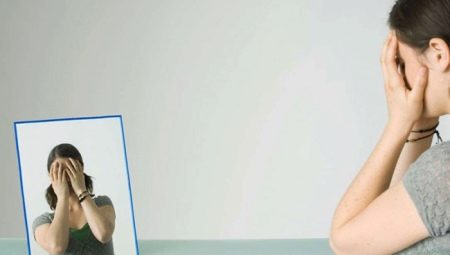
Almost every person had to experience fright at least once in their life at the sight of a mirror reflection of their own figure or other object in the twilight. Sometimes an all-consuming horror and exaggerated anxiety in front of reflection in a mirror, glass, water develops into a phobia. It is necessary to understand the peculiarities of the emergence of such fear. Is it possible to completely cure the disease?

What it is?
Fear of the mirror and its reflective properties is a rare phobia. It is called spectrophobia (from the Latin spectrum "image", "vision" + Greek phobos "fear"). Its variety is eisoptrophobia (from other Greek "mirror" + "fear"), in which an individual is afraid to look at himself in a mirror, glass surface or water surface. Looking at your own person in a mirror image triggers a panic attack.
Spectrophobia is a very serious mental disorder. Usually phobias arise from fear of harm to health or life.
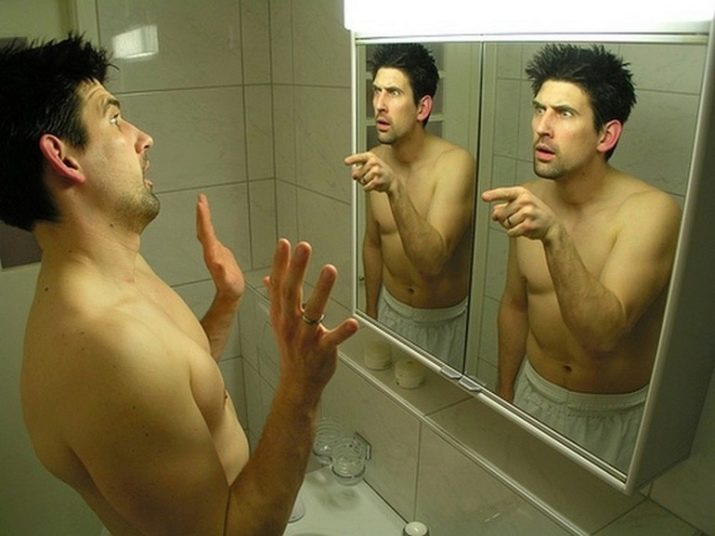
Unlike other fears, the fear in front of mirrors is difficult to justify, since the images in them cannot do any harm. The reason for the fear is purely psychological.
It is difficult for such people to be in rooms with mirrors. Trying to avoid them, a person begins to drop out of public life. The phobia sufferer turns away from shop windows, windows, stained-glass windows. He tries not to look at them. Houses are covered with mirrors and other reflective surfaces with dense fabric. The patient is afraid to see something frightening, frightening, but in reality non-existent, not real. And in these moments he feels the threat hanging over him.
Spectrophobes are timid, agitated, and nervous. They constantly look around to make sure there are no mirrors or glass surfaces. Entering a room with several mirrors, such people cowardly leave the room.
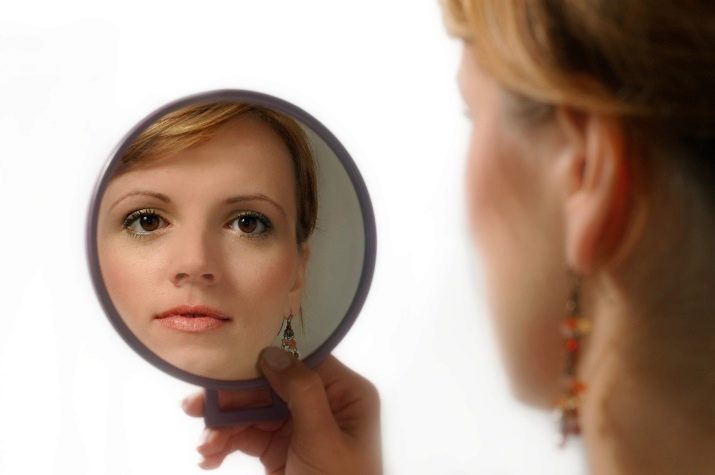
At night, fear intensifies, as there is an inexplicable anxiety to see in the mirror something more than your reflection.
The main symptoms and their diagnosis
The signs of eisoptrophobia are fears caused by the sight of one's own reflection in a mirror, glass and water surface, not only at night, but also during the day. The reluctance to be photographed is often caused by the fear of their photographs.
Fear of one's own reflection contributes to the appearance of symptoms of a mental and physiological level.
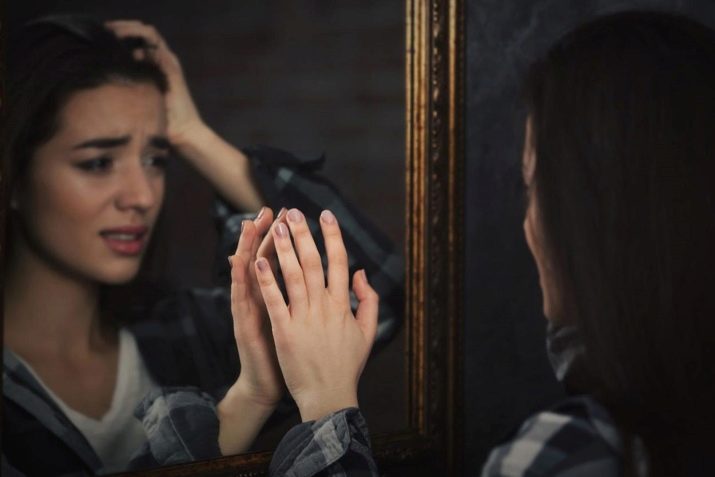
The disease is characterized by the following symptoms:
- all-consuming horror at the sight of your reflection in the mirror;
- fear of one's own appearance in the photograph;
- isolation, avoidance of communication with people;
- an irresistible desire to leave the room with a mirror;
- unexplained excitement, increased nervousness, alertness;
- obsessive thoughts;
- the emergence of fear of death;
- confusion of consciousness;
- asthma attacks;
- dry mouth;
- discomfort in the chest area;
- cardiopalmus;
- trembling sensation all over the body;
- the appearance of cold sweats;
- hot flashes;
- fainting;
- blanching of the skin;
- nausea;
- increased breathing.
An overwhelming fear and strong anxiety in front of reflective surfaces can appear in a person for a short time and disappear as the psyche stabilizes.

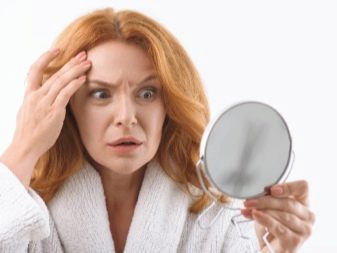
If the fear of mirrors persists for several weeks or months, you should see a psychotherapist and get diagnosed.
A qualified specialist, with the help of conversation and special tests, will establish an accurate diagnosis.
Causes of the disease
Failure to adequately assess the ongoing events, numerous own complexes can lead to spectrophobia. Certain reasons contribute to its occurrence.
- The phobia can be rooted in early childhood. The child, seeing in the mirror a terrible reflection of some object or phenomenon, was greatly frightened. The presence of a traumatic situation is deposited in the memory of the baby and ultimately leads to illness.
- Incorrect parental upbringing affects the development of a child's self-esteem, can provoke rejection of oneself, rejection of one's own reflection. The mirror serves as an irritant: a person is once again convinced of his inferiority.
- The negative experience of the past makes you dwell on nightmares that torment the victim. It happens that a person is unable to cope with a stressful situation, recover, and a weakened psyche is unable to withstand a new load.
- Unwillingness to accept an existing birth defect brings suffering when looking at oneself from the outside.
- A traumatic situation resulting in a severely disturbing recent physical disability (unexpectedly bald head, weight gain, broken nose in a fight, split lip, scar or burn on the face). A person is not always ready to accept his new image. At first, he tries to ignore mirrors, and then there is a fear of reflective objects.
- Mystical fear affects suspicious persons. Since ancient times, the mirror has been associated with a portal to another world. It was believed that through it the souls of the dead, ghosts, monsters, werewolves and other evil spirits could penetrate into the dwelling.
- Fear of accidentally breaking the mirror due to various superstitions. There are many folk signs associated with this subject.
- Occasionally, a phobia occurs due to a person's sexual dysfunction.
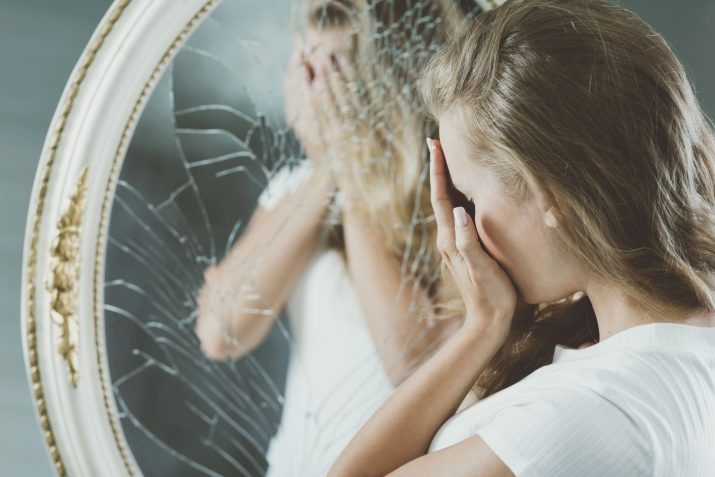
Treatment methods
At the first pronounced signs of spectrophobia or eisoptrophobia, it is necessary to seek help from a qualified specialist who will prescribe a comprehensive treatment.
Medications are aimed at normalizing sleep and eliminating panic attacks. The psychotherapist, depending on the indications and individual characteristics of the body, prescribes suitable sedatives, new generation harmless hypnotics, tranquilizers and antidepressants.

Self-medication with drugs can cause irreparable harm to the body.
Taking medications is carried out only as directed and under the supervision of a qualified specialist.
There are effective techniques aimed at eliminating spectrophobia.
- Psychoanalytic psychotherapy it is used for trauma to the psyche in childhood, the acquisition of a disease at an early age. Frequent visits to a psychotherapist and long-term treatment bring excellent results. This is the most effective method of therapy, but it requires a lot of effort on the part of the patient.
- Cognitive-behavioral approach is aimed at revising one's own "I" with an acquired defect. On the way to overcome fear, the patient is helped to recode his negative attitudes into a positive attitude.
- With the patient's disgust for his own body against the background of sexual dysfunctions of the body, the joint work of a psychologist and a sex therapist is required.
- Group lessons help to sort out problems, to alleviate the patient's condition and to consolidate the positive results of the fight against the fear of reflective surfaces. Together, it is easier to form a psychological and behavioral mindset to eliminate the phobia.

The specialist may suggest going through hypnosis sessions. The phobia sufferer is put into a trance state for a while. A complete shutdown of consciousness and activation of the subconscious makes it possible to replace frightening thoughts about mirroring, especially at night, with positive feelings and emotions.
The hypnologist corrects the psyche, directing in the necessary direction. At the end of the course of hypnosis, fears dissipate, the phobia is supplanted by positive thoughts:
- there is an adequate reaction to the sight of mirrors at dusk;
- there is an adequate assessment of the real degree of threat;
- reflective objects in mirrors are perceived as normal;
- the mental state is gradually recovering;
- the fear of the appearance of the reflection of terrible entities and mysterious phenomena in the mirror disappears.
Hypnotherapy is effective in treating spectrophobia. Each patient requires a personal approach.

The hypnologist's job is to help the patient. Otherwise, his condition may develop into clinical depression. The formation of new phobias should not be allowed. Then additional treatment will be needed.
With overwhelming fear, psychologists recommend replacing large mirrors with neat little mirrors. In order to avoid complications of the disease and the formation of other secondary phobias, when anxiety arises, it is best to avoid frequent gazing into reflective surfaces. You must always remember the complete harmlessness and safety of mirror reflection. It does not do any harm to the body.
You must gradually get used to your reflection. At the same time, it is advisable to note the positive in your appearance and say compliments aloud. Don't focus on looking for flaws. You should root out negative thoughts, set yourself up in a positive way.

The moment you look in the mirror, you need to force yourself to smile broadly. Do not allow a frown and unpleasant grimaces.
Working hard on yourself is a great benefit. Self-training includes the repetition of positive motivating phrases that allow you to change your own view of yourself. Relaxation is helpful in the treatment.Anxiety can be relieved by herbal tea, relaxing music and taking a bath with sea salt. To calm music, restless thoughts and unpleasant associations need to be transformed into pleasant memories. It is desirable to imagine the azure sky, emerald sea waves, golden sand, beautiful plants.

You can overcome fear at the sight of your reflection at night on your own. Breathing exercises and control over your own emotions are required.
Initially, the phobia sufferer must answer himself a number of questions:
- When did I become afraid of the mirror and the reflection in it?
- What can happen if I always focus on the mirror image?
- Why am I anxious, and how can I deal with it?
- Why am I afraid of my own imagination?
- What happens to me if I dare to look at my reflection in the mirror at night?
- Can I overcome fear on my own?

Before going to bed, you need to visualize your dream, remember the pleasant moments of life. To eliminate the fear of your own photography, you need to order a photo session from a highly qualified specialist who can please the client with high-quality beautiful pictures. During treatment, psychologists advise avoiding reading fantastic literature, watching horror films, and learning to clearly distinguish between the real and the fictional world.
See why people are afraid of mirrors below.








